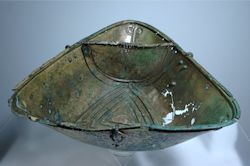

In Trøndelag, six Insular bronze vessels - including bowls, dishes and cauldrons - have been found (Heen-Pettersen 2013, 59). This is, however, a relatively small number in comparison with the western part of Norway where more than 30 bronze vessels are known (Jåtten 2006).
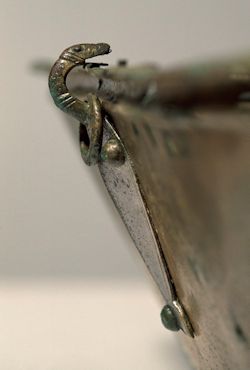
A large hanging bowl of Irish origin, found in 1986 at Skei near Steinkjer, represents a particularly rare type, remarkable both for its triangular shape and its massive size (Figure 14). Its only close parallel is represented by the far smaller triangular copper-alloy hanging bowl from Kilgulbin, Co. Kerry (Graham-Campbell 2001, 29). The Skei bowl's sides have an average length of 410mm and a depth of 130mm. Inside the bowl, a strainer plate is attached, decorated with a pattern of perforations in the form of a central rosette between a pair of roundels. The interior of the bowl, which has been patched, is decorated with ridges, whereas the exterior is mounted with three bird-shaped escutcheons, each having tinned wings and a three-feathered tail (Figure 15, Figure 16). This hanging bowl was found in a richly furnished woman's burial placed in a stone cist and is dated to around AD 775-800 (Stenvik 2001, 40). It was accompanied by a number of other items, including three other pieces of Insular metalwork: a gilded bronze mount, a large bronze ladle (Figure 18) and a small bucket of yew covered in decorated bronze plates of the highest quality workmanship (Figure 19). The Skei bucket is a close parallel to both the well-known bucket from Birka grave 507 (Youngs 1989, no. 120) and a bucket from Hopperstad, Stavanger. Graham-Campbell (2001, 30-31) and Stenvik (2001, 30) have argued that the buckets from Hopperstad, Birka and Skei are so similar – in shape, handle mounts and, in particular, the shared depiction of animals and bird in plant-scrolls on the bronze sheets, that they may have come from the same workshop.
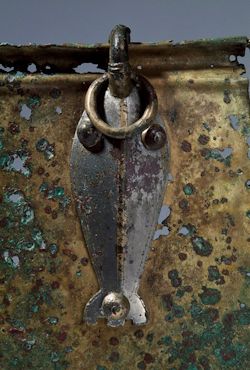
The bowl, ladle and bucket were found together at the foot end of the Skei grave, with the ladle partly overlying the bucket (Stenvik 2001, 12). The combination of such Insular items also occurred in the remains of a destroyed burial mound at Steinvik, Bjugn in 1894. According to an unpublished letter from the landowner (dated 25 May 1894), the Insular finds, comprising two bronze ladles, a bronze cauldron and fragmentary remains of a yew bucket, were found together under a large stone at the site of the mound, which had been levelled a few years earlier. In addition to the two examples from Trøndelag, the combination of such Insular items is also known only from the previously mentioned woman's burial at Hopperstad, Stavanger. Bødal (1998) has suggested that such artefacts may represent a fine and exclusive set of drinking or serving equipment. Graham-Campbell (2001, 33) has indicated a similar function for the Insular serving equipment from Skei, which may have been used 'on the high table'.

Only 12 bronze ladles, probably all produced in Ireland, have been found in Norway and five of these are from Trøndelag, from both male and female burials (Petersen 1940, plus recent finds). Only three of these can be given a more precise date, all of which can be placed in the first half of the 9th century. Two of the ladles were recovered from the grave in Steinvik, Bjugn, while the remaining three examples all come from the Steinkjer area. Raghnall O'Floinn (1989, 122) divides the Insular bronze ladles into two groups: those with long handles and small bowls and those with short handles and relatively large bowls. Only one of the bronze ladles from Steinvik, Bjugn, might be classed as long-handled with a small bowl (Figure 17), while the remaining examples from Trøndelag all belong to the latter group. One detail worth noting is the remains of a runic inscription and two overlapping ship symbols engraved on the back of the handle of the Skei ladle. The runes are believed to represent the three first signs of the runic fuþark alphabet (Hagland and Stenvik 2008). In addition to the example from Skei, runic inscriptions have also been identified on an Insular bronze ladle from Trå, Gardvin, in western Norway (Blindheim 1999, 51).
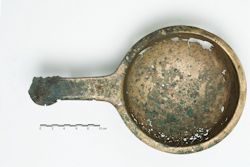
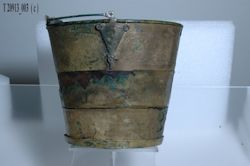
Carefully made buckets carved from single blocks of yew with a separate disc of yew added to form the base comprise an even rarer group of artefacts among the Insular material. They are usually no taller than 100-190mm and are covered with thin bronze mounts richly decorated with Insular ornaments, bearing witness to an expensive manufacture. Based on their decoration, Bakka (1963, 32) has proposed a Northumbrian origin within the Hiberno-Saxon art province for the manufacture of these particular buckets. No more than seven of these are known from Norway, and three of them are found in Trøndelag; at Skei (Steinkjer), Halsan (Levanger), and Steinvik (Bjugn). They occur almost exclusively in women's graves primarily dated to the 9th century (Stenvik 2001, 29). While the buckets from Skei and Halsan were complete when found, the surviving remains of the Steinvik bucket comprise just two handle plates with small fragments of the original bronze mounts attached (Figure 20). The function of such buckets in contemporary Norse societies has been little discussed, although it has been suggested that they may have been used to store or measure liquid, or perhaps materials such as flour and malt. Stenvik (2001, 29) has also proposed that they may have had an additional function as standardised measures of capacity.

Internet Archaeology is an open access journal based in the Department of Archaeology, University of York. Except where otherwise noted, content from this work may be used under the terms of the Creative Commons Attribution 3.0 (CC BY) Unported licence, which permits unrestricted use, distribution, and reproduction in any medium, provided that attribution to the author(s), the title of the work, the Internet Archaeology journal and the relevant URL/DOI are given.
Terms and Conditions | Legal Statements | Privacy Policy | Cookies Policy | Citing Internet Archaeology
Internet Archaeology content is preserved for the long term with the Archaeology Data Service. Help sustain and support open access publication by donating to our Open Access Archaeology Fund.
File last updated: Wed Dec 3 2014